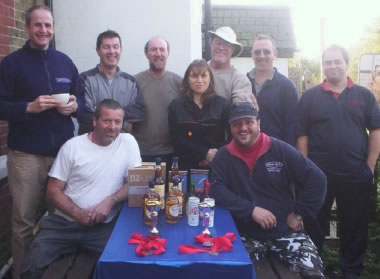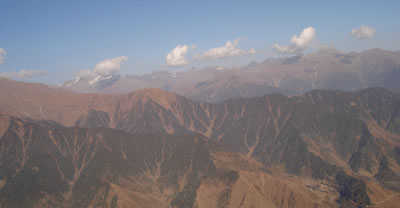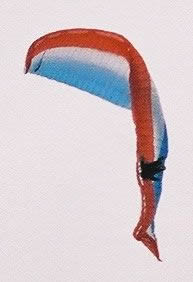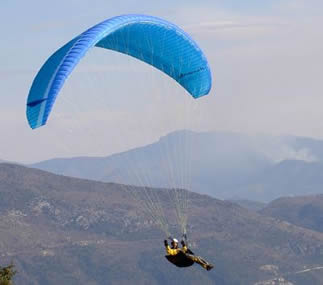News At Airworks
Why Choose Airworks?
Airworks Paragliding School endeavours to give you the best quality teaching environment possible. To achieve this, we keep our classes small with the highest instructor to student ratio possible. This is a crucial factor to ensure fast progression and above all - maximum safety.
Himalaya Trip - Paragliding in India Oct 06
We are just back from yet another awesome flying trip to Bir in the Himalayas. The reliability of this place never fails to amaze. We lost a whole 2 days from the month we were there!
Red Ribbon Club - Open PG Competition 29/10/06

Some of those involved in the first-ever Airworks Red Ribbon Club Open PG Competition held at West Firle on the South Downs on 29th October 2006.
(From L to R standing: Lucho Zuidema, Paul Midgley, Chris Aegerter, Diana Purdie, “Windy” John Lancaster, Bob Brooks, James Chapman. L to R seated: Rob Sanderson, Bernard Tagliavini.)
Overall Open Class Winner: Paul Midgley; 2nd place: Owen Latham with his 9yr-old daughter Millie, on their tandem; 3rd place:Lucho Zuidema.
Overall Red Ribbon Club Class Winner: Cally Dresser; 2nd place: Rob Sanderson; 3rd place: Chris Aegerter.
The slightly unusual format of the competition allowed pilots of vastly differing levels of experience to compete in a light-hearted fashion, side by side. A variety of tasks were run simultaneously during the day, which pilots could choose to try as and when they (and the conditions) were ready.
Himalaya Trip - Paragliding in India Oct 06
We are just back from yet another awesome flying trip to Bir in the Himalayas. The reliability of this place never fails to amaze. We lost a whole 2 days from the month we were there!
SIV & Skiing in Roquebrune Feb/Mar 06
A little marred by the weather, we still managed to do loads of SIV and find time to ski with the USA Olympic Mens Slalom Team, and fly at Sospel- see below for last year's report.
Himalayas Trip - Paragliding in India Oct/Nov 05
We are just back from yet another awesome flying trip to Bir in the Himalayas. The reliability of this place never fails to amaze.
Every day we were there, someone flew 100 km or thereabouts!

Once again, we took four staff and sixteen customers, many of whom had flown absolutely zero hours since qualifying, several were repeat offenders from previous years.
Most of us broke all our personal bests. Everybody wants to go again!
All in all, so much fun that we are now taking bookings for next years Himalayas trip :
If you are interested in any of the above Himalayas trips, call Airworks on 0044 (0)1273 858 108 for more details.
Andrew Beresford writes:
Close to the top of the world
The impending onset of our Winter might seem to be a good enough reason on its own for making the journey to fly the Himachal Pradesh region of India: it is quite a transition in every sense.
In a space of twenty four hours everything changes for the better: a benign climate, superb scenery and huge numbers of really friendly people in a vast space. Oh! And the flying. Mind you, there is a big brown hole called Delhi airport to cross and a longer-than-I-like road leading from it. If you can organise a flat tyre as an excuse for standing at the edge of a major highway and experience the swirling mass of people, bikes, rickshaws, banged-out lorries, mules, dust and dung then so much the better. But that’s India. Shutting one’s eyes might keep this out of mind along with other conventions such as dual carriageways with traffic going both ways on each, but it is hard to ignore the local predilection for continuously using the horn. Maybe it’s because brakes rarely work....
Everything about the comfort of our familiar Downs gets swept away on arrival at base. The main landing field is on the edge of Chowgan and, at 1420m, seems fair enough at the time of site briefing. The abundant Buddhist prayer flags decorating the outfield don’t seem out of place at this stage but they become close familiar friends for a lot of (mostly non UK) pilots. Albeit a few trees and bushes are scattered around it and, with the local resident monastery cricket games within it, one’s mind has a certain focus. Anyhow this field looks a better bet than the alternative one further out of the village and inconveniently draped with power lines around its margin.
Fifty minutes later we have driven continuously uphill on a track road to arrive at the Billing takeoff. The landing field is now difficult to spot but, having reached 2460m, this is not too surprising. It is now well over 2 km away and hazed below various inversions. Although since Delhi we ascended some 1 km to get to Chowgan, this vast mountain range abruptly tears out of the plain we are overlooking. Not many miles behind us there is a 5200m peak which is surrounded by other white pretenders. The horizon ahead is possibly more than 50 km away but the haze cloaks some of the enormity of the region. To either side, the ridges we will be flying are clearly in sight. They look ordinary enough and one readily imagines the strong but consistent thermals that spill off them during most of the day. However the reality is that this edge of the Himalayas probably has an average inclination of 30 deg and is deeply dissected by ravines and valleys such that any given slope can be pitched at some 60 deg or just be a huge vertical face. The nice flat plain below has some ‘streams’ running through it but later, on close inspection, they are seen to be river beds containing boulders the size of trucks. This is no gentle rolling place. It is dramatic and uncompromising. Carelessness or recklessness could certainly result in very serious walkouts.
All that being said, the first flight confirms that this is a safe area for paragliders provided that sensible respect is given to its nature and that a few essential adaptations to are made to flying behaviours: We are urged to land “hot and fast” in order to deal with the thinner air and the thermic conditions to be expected on landing. And then we are away. Well, not alone because are several pairs of watchful Airworks eyes to get us away and to observe all the individual flying styles. This is a good place to correct mistakes and ramp up the learning curve in a way that is inconceivable on our Southern sites. We all got thrown around a little in the thermals but soon learnt to keep these events under some control. At least with good height above ground level there is some extra time to deal with recoveries as compared with 50m above the Dyke.
Tutors also come locally. Himalayan Griffin vultures are superlative masters so at ease as to preen themselves where paragliders struggle to stay on station in a core. Their rate of ascent is extraordinary and so difficult as to be impossible to follow. Perhaps they are a little too laid back thus explaining one observed entanglement. (The bigger bird pulled his reserve and both landed safely.) These HGVs with their 2m wingspans are sought out as thermal markers and for the sense of superlatives they engender. According to Mark “The Eagle” Edwards there is also a group of local feathered hooligans ready to visit mayhem on particular decorative patterns of wing. Luckily, mine is somewhat plainer and hopefully won’t be physically or decoratively modified. At least by birds.
We were a friendly group of some dozen billeted on the edge of Bir in purpose-built accommodation in rural surroundings. It is partly run by Debu Choudhary who is now a comps veteran at the age of 26 having started flying when he was 14. When not on business or competitions he flies this area and is noticeable for landing on a sixpence in the field after the last 200m of his flights comprising a vertical descent of amazing tumbles that make the Russian State Circus look like a float on a river. One time his seat board broke with a loud crack. My own try at a spiral was distinctly pathetic by comparison although Hairy Dave did admit that he thought I would have found it “interesting” however I don’t think he worried for too long.
The Hindu Festival of Light, Diwali, culminated on November1st with Chris “Pataka” Craven exploding fireworks in competition with locals. We think he won by a blast but thankfully not on the scale of the September event at Patna. [An aside from the Daily Excelsior of Jammu and Kashmir: “Chocolate bomb, Chain Cracker, (Kali Pataka, Loose Cracker) "Dhani Patakas", Dodoma, Seven shots, Rocket Bomb, "Garland Patakas", "Star Bomb" etc. shall not be sold by wholesaler crackers dealers.” (sic) Sounds like a take-away!] Anyway, we were stoked up each morning with a hearty breakfast prior to being driven up for a cup of chai at the top. There, a surprising number of familiar faces from other British clubs were seen. Along with many Russians and others, they would ponder the moment for launching according to judgment and experience. In the thinner air this process is about commitment not difficulty.
Once launched, it was a matter of seeking the best lift and try to emulate successful pilots achieving a kilometre above takeoff. During our time this was about the best for any pilot because of the inversions but that was no bar to prevent lower airtime pilots from graduating to other ridges and flying the locality for a few hours. A hop of 1 km to the next one soon became the norm but the more experienced created for themselves the possibility for running the ranges off to the West. Subject to conditions, there were daily trips of 35 km to Palampur and beyond to Dharamsala. Dharamsala is another 25 km beyond Palampur and it has been the headquarters of the Dalai Lama since the imperialist Chinese take over of Tibet forty years ago.
It is a political fact of life that the Indians are paranoid about security in the region for Kashmir is nor far away. This means that you will not easily find good maps, certainly not modern ones, and those you can get are original British surveys of India. These are adequate for orientation but possibly unnecessary because of the near miraculous emergence of any form of transport when landing out. I guess that 40% of our landings were ‘out’ and some of those that were ‘in’ might better have been ‘out’ (of sight) as trees and cows bore silent witness. Almost before landfall (no pun intended) a school of children comes as if from nowhere to besiege you with interest and some degree of respect. They are totally enthusiastic about our experiences. The people are an example: simply put, they make one ashamed of the manner of treatment that some of their compatriots can experience back in modern Britain. After a little gentle negotiation you have a “means of transport” at your disposal to whisk you off to Bir or Baijnath. The latter is a local hub networking many bus routes across the region and give you another world of experiences. Where else would you see an upright raj-moustached figure sitting in the seat in front holding a 1910’s blunderbuss as if it were a shopping bag? Certainly not in America. One way or another it’s not difficult to get back to base and share the day’s experiences. There are some snags about the busses: how to interpret the Hindi squiggles as names of places is one. According to story, a couple of years ago one unfortunate seeking urgent relief behind the bus stop late at night got comprehensively munched by something with large teeth. It is better to ask about those directions and also avoid the resident troupe of monkeys. Once on the bus, the next snag is that you can expect to be pressed very close against skinny old men with no teeth or sleek young college ladies just out of school. Just think about the day’s adventures if you prefer.
The area is full of colourful character and positive experiences. Yes, there were some problems, especially for some Eastern European pilots who were either poorly trained or overly ambitious about their abilities. The place demands the safe hand of experience for first trips and it is more fun anyway when in company. We had a number of approaches during our own debriefings in local cafes from individuals who appeared to have little idea about what they had come into. Heaven knows what they did when in need of support and/or without insurance. Their outlook in those circumstances would prove to be very grim indeed.
Thanks to the Airworks crew we had a great experience overall and assistance when difficulties arose. It’s a “must do”. As they put it on eBay: “Would buy again. Thanks A+++++”.
©Andrew
Beresford 2006
This article may be freely reproduced provided that it is done so
in full and is not incorporated within a publication for sale.
Airworks Forum - May 05
We have just set up a smartgroup forum to help us communicate with everyone. This works as an e-mail forum, a calendar and all sorts of other functionality that I haven't had time to investigate.
How new members can join AIRWORKS smartgroup:
Click here or go to http://www.smartgroups.com/groups/airworks and join the Group or New members can email airworks-subscribe@smartgroups.com
Monaco SIV Feb 2005


One of the most stressful moments for us was when Barbera 'The Navigator' Innwater (name changed to protect identity,) on not hearing any instructions to the contrary, decided to continue in a straight line until most of the way to Africa. Fortunately there was an onshore breeze, so she only missed the beach by about 500m. The worst part was that she was on a glider we'd lent her...
This occurred on her first flight, but like everyone else, she was confidently stalling and recovering her glider by the end of the trip.
It is great to watch pilot's confidence in themselves and their equipment improve during an SIV course: Mere asymmetric deflations hold so little fear that they become almost routine and the full frontal is almost a non-event. The really good part about doing SIV training in Monaco is that you have a frame of reference, unlike Olu Deniz, where you often cannot see the ground at all, the visibility is so poor. This frame of reference and the air's clarity help you to establish how much height you are losing in any manoeuvre and so establish whether you are improving your skills and also helping to build a database of safety heights below which, in the real world, you would elect to deploy your reserve, rather than struggle to fix a problem for which you have insufficient height.
The next group of pilots were of a far more hydrophobic disposition, and after almost a week of un hydrated flight it became too much for our inimitable Bin Hairy Dave to bear. He determined that he would SAT his brand new Mustang, because it was soooo easy... What he forgot however was that even Mustangs cannot glide at 20:1 and so performed a near perfect demonstration of a water landing, which the group would otherwise have missed.
Another interesting and often entertaining element of Monaco is that many European manufacturers choose it to develop and test their latest creations, so it is not at all uncommon to witness luminaries of the free flight world tuning their wings and turning as yet unbadged creations into crumpled tissue and back into gliders again.

Omega 7?? (Competition prototype Omega 6)
Himalayas Trip - Paragliding in India Nov 04
We are just back from another awesome flying trip to Bir in the Himalayas. 33 flyable days out of the 35 we were there!

We took four staff and sixteen customers, many of whom had flown absolutely zero hours since qualifying... We left with twenty very experienced pilots!
Most of us broke all our personal bests. Everybody wants to go again!
>>Photo AlbumIf you are interested in any of the above trips, call Airworks on 0044 (0)1273 858 108 for more details.
>For more information visit our paragliding holidays and trips page.
